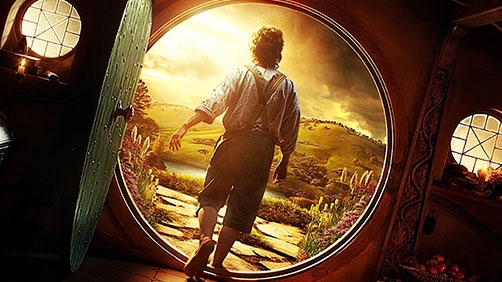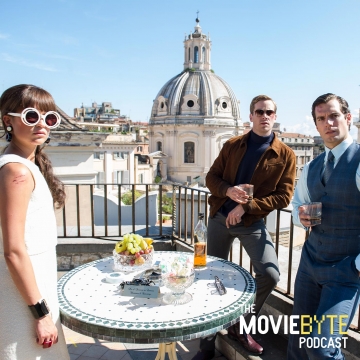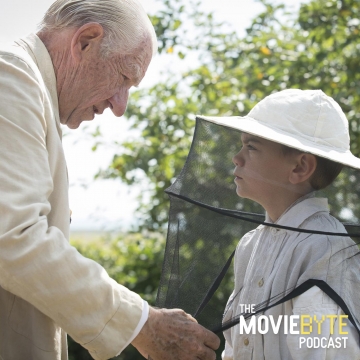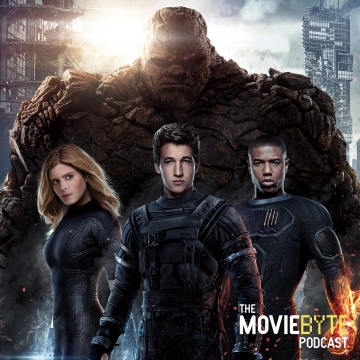
“Good Morning!”
“What do you mean? Do you wish me a good morning, or mean that it is a good morning whether I want it or not; or that you feel good this morning; or that it is a morning to be good on?”
It has finally happened, a little out of order perhaps, but it has happened none-the-less, and it was good. What is possibly J.R.R. Tolkien’s most notable, or known work, certainly his first notable work, has come to the big screen. And it was not a small undertaking either. The same, much lauded production values, acting talent, story telling, sense of style and scope, and epic feel have been brought to this film as we saw in Lord of the Rings.
Much — very much — has been said by many, many people, audiences, film critics and more, on the subject of the Lord of the Rings trilogy, and I’m sure in the future MovieByte will do full reviews of those films as time permits as well. Never-the-less I feel a little back story of my own personal setting and feeling about those previous films, to which this film is a prequel, is necessary.
Origins

I must confess that I have never been into Tolkien’s writing, though I love fantasy literature. I’ve tried to read both The Hobbit, and The Lord of the Rings trilogy. I think what it amounts to for me is that I find his writing to be terribly dull, spending way too much time on trivial and meaningless details best left to appendices and the additional explanative books that the uber nerds read.
That said, when my wife and I first started dating, she insisted I was going to need to see the Lord of the Rings trilogy. I watched it with her, and it re-ignited my passion for fantasy films. Though I suspect that I felt more highly of the films then than I do now, yet I still consider them to be foundational fantasy films and required watching for pretty much everyone.
My one caveat which will become relevant later in my review is that I prefer the extended editions, though not perfect. Actually, my feeling on this matter is somewhat mixed. While the original theatrical cuts seem to leave necessary details out, the extended editions seems to be a bit slow moving and dull at times, full of endless places where trimming could have taken place. I wish there was something in between.
But in any event, suffice it to say that I love the Lord of the Rings films by Peter Jackson.
A Trilogy
Originally, The Hobbit was to be two films, and it was not going to be directed by Peter Jackson, but rather Jackson was going to produce and Guillermo del Toro was to direct. Due to a number of complicated circumstances, including financial difficulties on the side of one of the studios involved (MGM), delays caused the departure of del Toro. Though it would have been interesting to see del Toro’s vision for the film, it is certainly nice to have a more consistent look and feel with the universe of The Lord of the Rings.
As the fan fervor continued to grow in anticipation of the two films, Jackson announced that the two would become three, that there was just more material there than he had realized.
The First of Three
I sat down with family, friends, and my six year old son in my local Carmike theater and we watched Bilbo’s unexpected journey unfold. We laughed at Bilbo’s grumpiness at having so many Dwarves in his home, we sat on the edge of our seats when it seemed they were all done for, we cried (well, almost) at the telling of Thorin’s backstory, we were shocked when Azog wasn’t actually dead, and all that stuff. And of course, when Bilbo says at the end of the film, “I do believe the worst is behind us!” I think everyone in the theater got a pretty good laugh out of that.
All in all this is a satisfying first installment in The Hobbit trilogy and I think it sits in very nicely with the Lord of the Rings trilogy.
A Halfling

One of the great delights of this film is the acting of Martin Freeman as Bilbo Baggins. While it’s a little inconsistent to have someone other than Ian Holm playing Bilbo (as he wasn’t supposed to have aged a day after acquiring the ring) it’s still delightful and easy to overlook. Martin Freeman brings a sense of vigor to the role, and offers a very great performance and a great range of emotion as you would expect Bilbo to experience on this eye opening journey for him.
And of course it’s pretty moving when Bilbo charges in to a pack of Orcs about to finish Thorin off. This is such a great character moment and it is handled with skill.
The Grey Wizard
“Saruman believes it is only great power that can hold evil in check, but that is not what I have found. I found it is the small everyday deeds of ordinary folk that keep the darkness at bay. Small acts of kindness and love. Why Bilbo Baggins? Perhaps because I am afraid, and he gives me courage.”
Never a better casting choice could have been made for the character of Gandalf than Ian McKellen, and seeing him return to the role is good news. He is truly a great actor and one can very easily forget that it has been many years since he played the role of Gandalf in Lord of the Rings. Indeed, you can’t really tell it at all. And there is plenty of action for him here as well.
Seeing him pull one over on Saruman while appearing to be bewildered and completely innocent is such a great scene in the film as well.
Dwarves
While keeping that many characters names and faces straight is a challenge (I couldn’t tell you all the names of the dwarves, or which one goes with which name), a couple stand out. Obviously Thorin, and I thought he was well cast and well acted. You definitely get the sense of his pride and arrogance, something I’m told is very much in keeping with the book.
What is a Bagginses, precious?

And of course, returning to the role of Gollum is Andy Serkis. There is not another man alive on the face of this earth that was born for this role as he was. The scenes between Gollum and Bilbo represent some of the film’s darkest and funniest moments at the same time.
We see immediately that old Gollum, ready to eat Bilbo (“Oh, we like goblinses, batses, and fishes, but we hasn’t tried Hobbitses before. Is it soft? is It juicy?”), but in his sing songy and playful, nasty way. Ever the entertaining villain.
Epic
While the story of The Hobbit is a far lighter tale, particularly in the books, Jackson manages to bring to the story the same sense of wonder, awe, and feeling of epicness that he did with The Lord of the Rings. This mostly serves the film well, though at a very few points it feels like the film is being trumped up beyond its appropriate scope just a bit.
That said, the production values in play here are tremendous and at times breathtaking, just as they were in Lord of the Rings. And in the vein of the epic story, one opportunity this film affords is to be able to do a bit of appropriate retrofitting of the story into Tolkien’s larger universe. When Tolkien wrote The Hobbit he had not conceived of the Lord of the Rings trilogy and so some things were naturally a bit out of place, or were not told in a manner completely consistent with what was to come. And honestly, even some of the most avid fans of the book have told me that they have been okay with most of the changes or additions that Jackson has brought to the film.
Just as an instance, we actually see and meet Radagast the Brown, and this is incorporated well with the storyline of the Necromancer (Sauron). And of course The White Council is not exactly in the book, but easily extrapolated.
Trouble in Middle-Earth
I can’t say I was pleased with everything about The Hobbit: An Unexpected Journey. As I alluded to, I have a little bit of trouble with the length, and expanding the story to three films. I tend to think that any film over two hours is probably fat around the mid-section and needs to go on a healthy diet. There are exceptions, but I do not believe this is one of them. Perhaps it is my editor’s brain playing tricks on me but there were so many moments that I felt could use some trimming and shaping that it spoiled my enjoyment a little bit. There are several fight scenes that just go on for too long. When I stop caring about the fight and just want to know the outcome, the fight has lasted too long.
And to think this is the reason the films were expanded from two to three is just maddening. It feels like we have skipped right over the theatrical versions of these films and straight to the extended editions (and it terrifies me that there probably will be extended editions on top of this). I have the same feeling here that I do about the extended editions of Lord of the Rings, namely that it would be nice to find a middle of the road somewhere in here.
Also, why was the Stone Giants scene added in the first place since it wasn’t in the book (as an action scene) and served no purpose. More importantly, why wasn’t it cut in the editing bay? It was completely pointless.
Poor CGI

Strangely, though Lord of the Rings was on the cutting edge of CGI technology, and while there is plenty of great CGI in The Hobbit, there was also some stunningly bad CGI in this film as well. Any scene with Azog for instance was stunningly bad. I was shocked at how CGI fake he looked.
Many of the battle scenes look entirely too clean, antiseptic like, as opposed to The Lord of the Rings which often featured a gritty realism.
The other scene that comes to mind is when Gandalf is dismounting his eagle ride on the mountain top. It looks almost video-game like. It’s almost as if they ran out of time and money to do the final renders on these elements — although, I don’t know if that’s true since Peter Jackson seems to enjoy the video game look over the cinematic look (i.e. 48 FPS). Speaking of which…
FPS
I was unable to see this film at it’s touted 48 Frames Per Second frame rate. There were some complicating factors, and I am somewhat disappointed that I have not been able to do so.
The reason is I did want to give it a chance. And for this reason. Again, these are subtle things, but I could definitely tell there was a distinct lack of motion blur in camera movement, and fast movements in general. I’ve talked about this before, but it gives the picture a more vivid and stroby feel, with fast moving images it is as if you are seeing them in two or three places at once. The effect is decidedly not pleasing and not cinematic. So for viewings of The Hobbit at 24 FPS, even though this is the normal frame rate, the difference is notable since it was filmed at 48 FPS. This is why I wanted to see it also at 48 FPS so I could evaluate the product as Peter Jackson intended it to be seen. And maybe I’ll wind up ponying up the money later to do so and write an article about it then. But since the lack of motion blur is caused by filming at a higher frame rate, I don’t expect it to look better, but worse.
And it’s not just me. My wife, who does not understand these sorts of technical details at all, asks me after the film why some of the scenes looked bad. After digging a bit, I found she was complaining about the lack of motion blur. So even though she knows nothing of frame rate, she didn’t like it at all.
Over at Clickonline.com, Daniel Anderson had this to say:
On the subject of those 48 frames, there’s no getting around the fact that familiar human motion looks naff. Movements feel sped up rather than smoother and camera pans judder across the screen – looking for all the world like something shot on a low end camera system. You may notice that The Hobbit is almost free of live action crowd scenes and there’s a reason for that – the glimpses of groups of humans in Dale in the prologue have the look of the kind of cut rate reconstruction you might see on a History Channel documentary. Motion looks unnatural and the look too sharp and HD.
While in many ways I feel he’s a little harsh on the film, many of his complaints are legitimate. And I think this one is too.
Howard Shore
And so that I don’t end on a sour note, because all-in-all I really did like it, I must mention Howard Shore’s excellent score. His Lord of the Rings score was very well done and I only have minor complaints with it. Since then I have not been impressed with his other work. Particularly his work on the Twilight film Eclipse was lackluster and a bit repetitive of himself.
However, his music on this film is absolutely inspired. I can’t get the primary dwarf theme (the track Misty Mountains introduces it as a sung piece) out of my head. Particularly good use of this theme is found in the track Over Hill at about 3:06, but in so many other places is that theme woven and incorporated.
I think what makes the score particularly compelling is Shore’s use of themes from the Lord of the Rings trilogy where appropriate, such as Gollum’s Theme, the theme for The Ring, foreshadowing of the theme for Mordor and more. Such foreshadowing and call backs are done throughout the entire soundtrack but never such that it felt like Shore was simply repeating himself, it’s really good. If you don’t have this soundtrack yet, what’s wrong with you??
Thumbs Up
It’s definitely worth taking a trip to Middle-earth with this film, despite any complaints I have. I’ve wrestled with just how many stars to give this film, and you have no doubt noticed at the top of the review that I gave it 3.5 stars. I think that’s fair. Remember that 2.5 is neutral so it’s definitely on the positive side of my scale. Know that I seriously considered a 4 star rating. And I could see myself coming around to that way of thinking in time. For now, get out there and see it!


